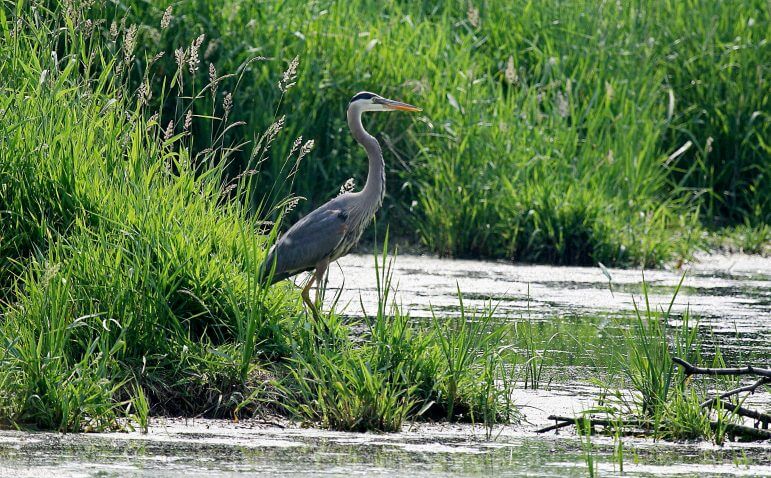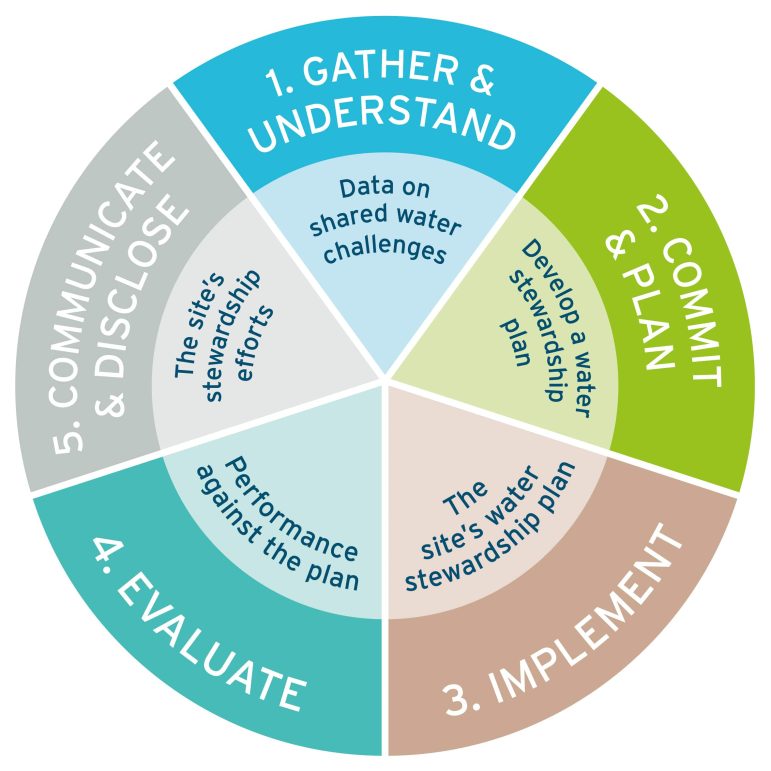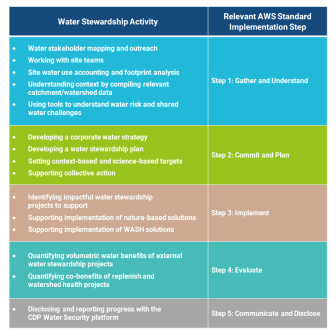The Alliance for Water Stewardship Standard – Framing a Decade of Water Stewardship
The AWS Standard has gained significant traction globally. Sites engaging in the AWS Standard framework are guided to see water stewardship activities more holistically within a watershed context. The AWS Standard helps drive change and identify opportunities beyond facility operations.
By Laura Weintraub, Vice President and Senior Engineer (Ann Arbor, MI)
May 12, 2022
Let’s start by going back about a decade. LimnoTech was honored to be part of a research team that explored whether a new, emerging water stewardship standard could possibly be applicable and useful to industries located in the water abundant region where I live – the Great Lakes. These five beautiful lakes are ‘salt-free oceans’ that hold 20% of the world’s freshwater. We wanted to know if seeking a “water stewardship certification” would make sense for industrial water users that rely on this abundant source. Our work tested the pre-release of the AWS Water Stewardship Standard on five facilities representing a cross-section of industries: an electric power plant, a cement plant, two paper mills, and an oil refinery. We worked directly with facilities and provided feedback to AWS to help advance the AWS Standard certification tools and guidance. What we concluded was promising. We determined that the AWS Standard provides a credible framework for assessing industrial water stewardship in the Great Lakes region.
LimnoTech was honored to be part of a research team that explored whether a new, emerging water stewardship standard could possibly be applicable and useful to industries located in the water-abundant Great Lakes region.
Although Great Lakes industrial facilities have worked for years to improve in‐plant water use efficiency, the AWS Standard can serve as a framework to push industry “beyond the fence line” to identify and implement measures to protect and enhance water resources. Sites engaging in the AWS Standard framework are guided to see water stewardship activities more holistically within a watershed context. The AWS Standard helps organizations drive change and identify opportunities beyond facility operations. The AWS Standard recognizes that water stewardship is not just about addressing scarcity risk. The five desired outcomes appropriately and holistically frame water stewardship as an opportunity to implement meaningful, water-related actions in areas that matter the most in a given context.
Five desired outcomes of water stewardship (Image Credit: The Alliance for Water Stewardship).
Fast forward 10 years. The AWS Standard has now gained significant traction globally. Food and beverage companies were early adopters of the AWS Standard. As of spring 2022, over 235 sites across the world are now certified. This represents a diversity of sectors including agriculture, chemical, food and beverage, electronics and semiconductor, health care, paper and forest, telecommunications, textiles, and other industries. The geographic spread of certified sites includes over 50 different countries.
We, at LimnoTech, are grateful to have been a part of this exciting ride. We were trained in an early cohort to become experts in helping companies apply the AWS Standard. Our team of seven professional credentialed scientists and engineers have helped train and support numerous organizations in the food and beverage, electric power, industrial manufacturing, high tech, and agricultural sectors as they have used the AWS Standard framework to guide their water stewardship journey. In 2020, we supported Google in certifying three office campuses in California and Dublin, Ireland. We’ve helped other companies in a variety of sectors implement the AWS Standard – some have pursued certification, while others have chosen to follow the framework at a level that suits their organization.
LimnoTech supported Google in certifying three campuses under the AWS Standard: two in California and one in Dublin, Ireland.
So how has the AWS Standard brought value to these organizations and how might it bring value to your organization? We’ve seen numerous companies use the AWS Standard as a vehicle to enter and advance their water stewardship journey in the following ways:
- Motivate sites to improve water accounting and quantify uncertainty in the site water balance
- Establish cross-functional water stewardship teams, break down silos and drive collaboration
- Combine differing organizational efforts under a common theme of water stewardship
- Create relationships, tools, and language to bolster a corporate water stewardship strategy
- Catalyze and enhance external engagement with key watershed stakeholders
- Gain contextual awareness of how the organization fits into a broader water system and identify shared water challenges
- Identify opportunities to address shared water challenges through collective action
- Drive internal and external alignment on water
- Commit to continual Improvement
- Confirm that the intent, spirit, and requirements of the AWS Standard framework are met through third-party assurance
In five logical steps (see graphic below), the AWS Standard weaves together the key elements of any corporate water stewardship journey. The flexibility of the AWS Standard provides a robust, yet adaptable, framework to meet a company where they are on their own water journey. For example, a company just starting to think about water may focus AWS Standard implementation primarily on data collection, risk identification, and initial outreach with key watershed stakeholders to fully understand shared water challenges. Another organization may already have a strong, but fragmented foundation of water stewardship activities. In this case, implementation of the AWS Standard may focus on integrating activities into a cohesive effort, while still striving to stretch goals and for continuous improvement.
Five step process to implement the Alliance for Water Stewardship Standard (Image Credit: The Alliance for Water Stewardship)
Regardless of the unique path each company takes along their own water stewardship journey, a common set of elements play an important role and are woven together within the various steps of the AWS Standard framework.
As leaders in the corporate water stewardship arena, LimnoTech continues to help companies navigate their water stewardship journey. We provide client-focused and science-based solutions in all of these areas to construct building blocks that are critical for the streamlined implementation of the AWS Standard – but more importantly for a successful and impactful water stewardship journey.
In the coming months, we’ll share a series of articles to dig deeper into many of these topics in the context of the AWS Standard framework. We hope to shed some light on these important topics and pathways that sustainability-focused companies can take to demonstrate leadership and drive a positive impact in their watersheds, through their water stewardship investments, activities, and collaborations.
If you would like to discuss water stewardship, please contact me at lweintraub@limno.com.
Follow us on LinkedIn or Twitter (@LimnoTech) and check the Insights & Perspectives page on our website for more information and updates.
Links to the other water stewardship articles in this series are provided below:
Understanding and Engaging Water-Related Stakeholders
Assessing Water-Related Risk as a Foundation for Stewardship
Success Strategies for Developing a Site Water Stewardship Plan within the AWS Standard Framework
Strong Site Teams Lead to Successful Water Stewardship
Laura Weintraub, PE, is a Vice President and a Water Resource and Environmental Engineer with over 25 years of experience supporting public, private, and research clients in the areas of watershed planning, water sustainability, stormwater management, source water protection, and decision-support system development. She currently co-directs LimnoTech’s corporate water stewardship practice area where she supports numerous companies in tech, food & beverage, manufacturing, electric power, agriculture, and other sectors. Laura leads projects to support sustainability-focused companies with water stewardship strategy and target setting; water stewardship program development and implementation; water accounting, footprinting, and circularity assessments; context-based water risk assessments; replenish project scoping and benefit quantification; Alliance for Water Stewardship Standard training and certification; and sustainability reporting. She has also led efforts to evaluate water risk and sustainability metrics, assess opportunities for alternative (degraded) water supply use, and quantify the economic costs and benefits of water stewardship projects implemented outside the fenceline of an organization’s operational boundaries.
The content herein is the author’s opinion and not published on behalf of the Alliance for Water Stewardship (AWS). The author holds an AWS Professional Credential and this piece of publishing helps fulfill their Continuing Contribution Units requirements. For more information about AWS or the AWS Professional Credentialing Program please visit https://a4ws.org/.







